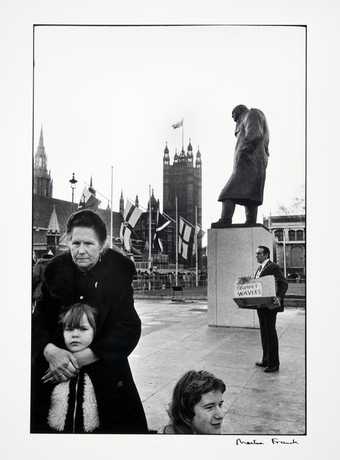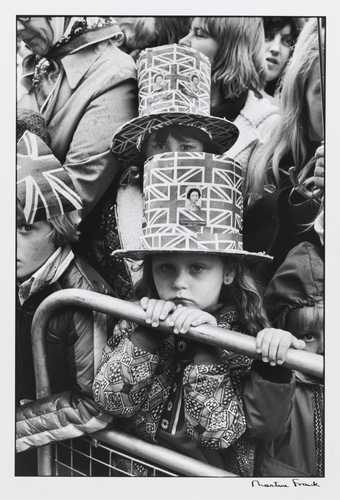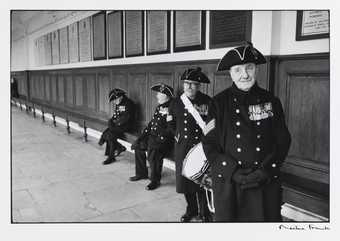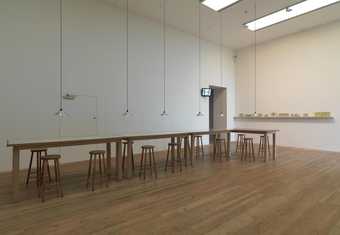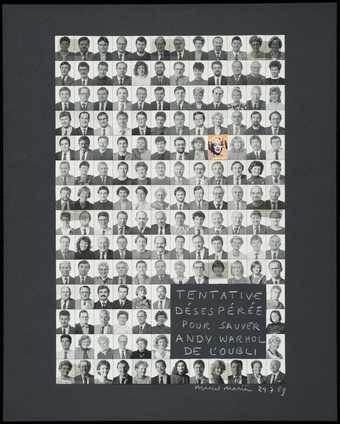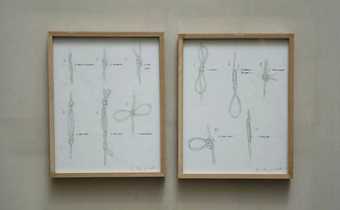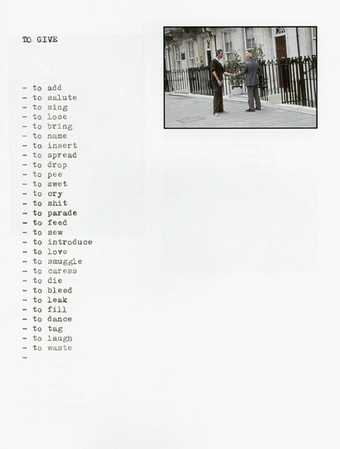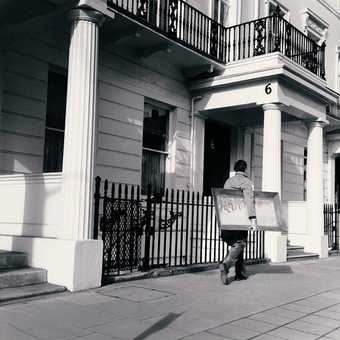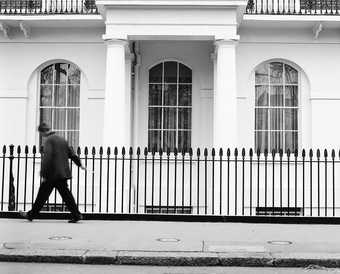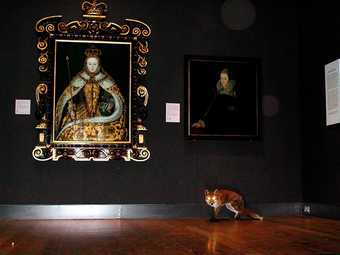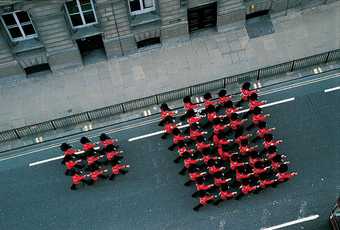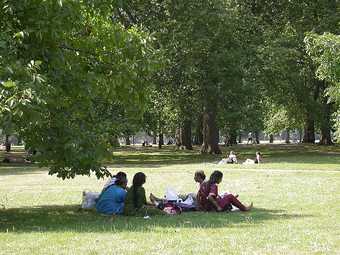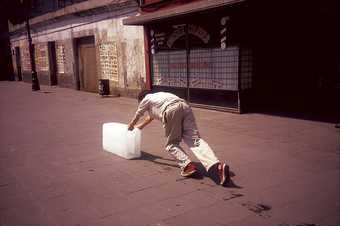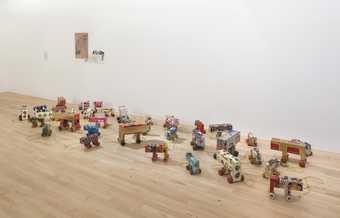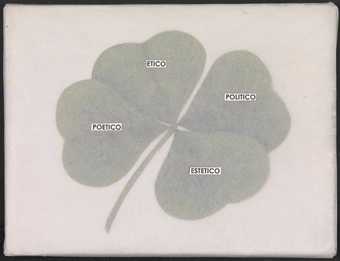
Not on display
- Artist
- Francis Alÿs born 1959
- Medium
- Ink on paper
- Dimensions
- Overall display dimensions variable
- Collection
- Tate
- Acquisition
- Presented by Tate Patrons 2006. The Artangel Collection at Tate
- Reference
- T12193
Summary
Pebble Walk is a postcard showing an aerial view of London’s Hyde Park, photographed from the north-west corner. Beneath the image is a typewritten caption: ‘A walk from the North west end of Hyde Park to the south east end of Kensington Gardens, from 12:25 PM till 1:35 PM concluded with 7 stones in my right shoe and 3 stones in my left shoe’. The postcard can be mass produced and distributed to exhibition visitors when other works from Tate collection’s by Alÿs, such as The Nightwatch 2004 (Tate T12195) and Guards 2004 (Tate T12196), are displayed.
Pebble Walk documents Alÿs’s private action of walking across the park. The resulting documentation combines a universal view of the metropolis (a typical postcard image featuring the skyline and London’s famous red buses) with the precise, private and mundane details of Alÿs’s experience. The resulting bathos has been noted by the art critic Gabriel Coxhead: ‘[Pebble Walk] is a deprecatingly inadequate summary of those vast, flat spaces but an accurate representation of the way events and places are humanly experienced or remembered’ (Coxhead 2005, accessed 5 March 2016). Alÿs’s documentation of his action recalls the traditions of happenings and Fluxus, but also playfully inverts the land art movement, in particular Richard Long’s A Line Made by Walking 1967 (Tate P07149). As Alÿs noted in 2005:
[Pebble Walk] is a kind of homage to Richard Long, but it’s inverting the mechanics of the work. With Richard Long there is often a voluntary act of removing something, or reconfiguring a certain form in the landscape, drawing a line or making a circle of stones… In the postcard piece I made in Hyde Park, I walked and there was an involuntary consequence to my walking, which was that a few small pebbles entered my shoe.
(Quoted in 21 Portman Square 2005, p.48.)
A Belgian artist residing in Mexico City, Alÿs undertook the Pebble Walk action in 1996 when he first began to explore the city of London. However, Alÿs had long been creating postcards as part of an expansive practice which also includes film, performance and painting. His postcards are also represented in Tate’s collection by a set of twelve he created to accompany Collectors 2006 (Tate T12410).
Pebble Walk is one of nine works in Tate’s collection from Alÿs’s series Seven Walks. This series was created over the course of six years, as Alÿs wandered the streets of London and mapped its habits, rhythms and rituals in a range of different media. In 2005 the resulting films, videos, paintings, photographs and drawings became Seven Walks; works which either documented the artist’s own walks or those enacted by others on his behalf. The art critic Coline Milliard has stressed how the series humanises the city in which it was made:
Alÿs’s walking creates a ground-level image of the city, fragmented, subjective and incomplete. It claims space for the fragile, the ephemeral and the poetic. In a commuter city where pedestrianism fights for survival, ‘Seven Walks’ transforms increasingly alienating surroundings into a new space tailored to human dimensions.
(Milliard 2010, p.4.)
Alÿs has used walking as an impetus for his work throughout his career, including in early pieces such as The Last Clown 1995–2000 (Tate T07993). Other works in the Seven Walks series include Sunny/Shady 2004 (Tate T12197) and Railings 2004 (Tate T12194).
Further reading
Francis Alÿs: Seven Walks, London 2004–5, exhibition catalogue, 21 Portman Square, London 2005.
Gabriel Coxhead, ‘Ephemeral Images in the City’, Financial Times, 4 October 2005, http://www.ft.com/cms/s/0/d40785aa-34c0-11da-9e12-00000e2511c8.html, accessed 5 March 2016.
Coline Milliard, ‘Walks of Life’, Art Monthly, vol.337, June 2010, pp.1–4.
Phoebe Roberts
March 2016
Does this text contain inaccurate information or language that you feel we should improve or change? We would like to hear from you.
Explore
- architecture(30,960)
-
- garden structures(1,939)
-
- park(320)
- townscapes / man-made features(21,603)
-
- street(1,623)
- townscape, distant(8,109)
- formal qualities(12,454)
-
- documentary(1,026)
- photographic(4,673)
- recreational activities(2,836)
-
- walking(144)
- reading, writing, printed matter(5,159)
-
- postcard(221)
- UK countries and regions(24,355)
-
- England(19,202)
- transport: land(2,189)
-
- bus(109)
- inscriptions(6,664)
-
- artist’s notes(1,553)
You might like
-
Martine Franck Princess Anne’s Wedding, Parliament Square
1973, later print -
Martine Franck Greenwich, London
1977 -
Martine Franck Chelsea Royal Hospital, London
c.1973, later print -
Francis Alÿs The Last Clown
1995–2000 -
Marcel Mariën Desperate Attempt to Save Andy Warhol from Oblivion
1989 -
Francis Alÿs Knots
2005 -
Francis Alÿs The Commuters
2005 -
Francis Alÿs Railings
2004 -
Francis Alÿs The Nightwatch
2004 -
Francis Alÿs Guards
2004 -
Francis Alÿs Sunny/Shady
2004 -
Francis Alÿs Ice 4 Milk
2004–5 -
Francis Alÿs Collectors
2006 -
Francis Alÿs Untitled
2000–10

